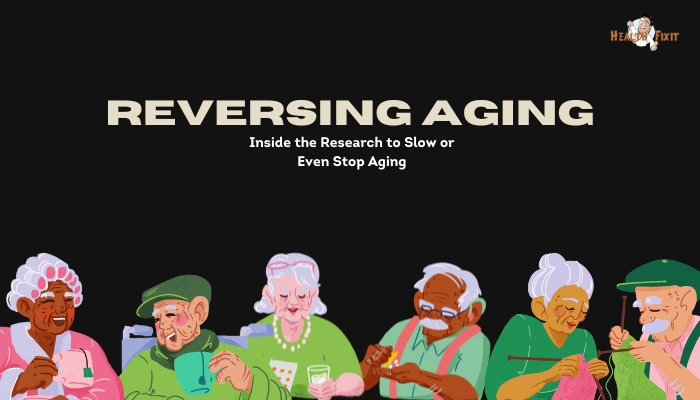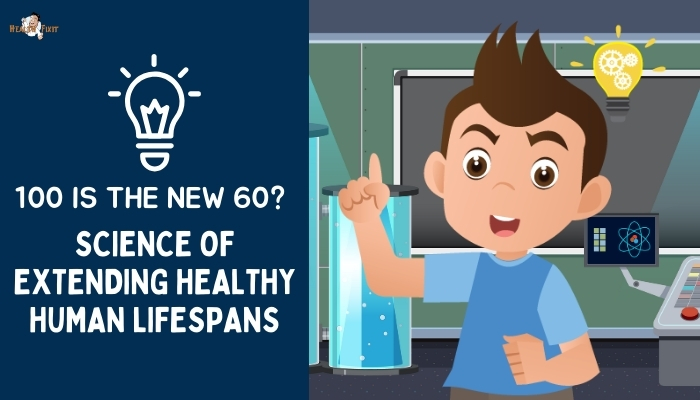Introduction
Aging affects every person throughout life. Most adults see aging as a natural part of living, marked by changes in appearance, physical performance, and increased risk of disease.
Researchers, however, probe deeper than ever before to discover the underlying processes that drive aging.
Their objective is to identify interventions that slow, halt, or even reverse these processes at the cellular and molecular levels.
Science has revealed multiple factors involved in aging. Cells lose the ability to divide correctly. Genetic material becomes unstable.
Metabolism shifts in ways that encourage chronic disease. Epigenetic markers accumulate, altering gene expression. Telomeres at the ends of chromosomes shorten, limiting a cell’s replicative capacity.
Senescent cells build up and cause inflammation in tissues. Such findings indicate that aging is not a singular phenomenon but a layered set of problems. This complexity means that reversing or preventing aging might require multiple approaches.
Researchers investigate molecules such as rapamycin and metformin for life-extending effects. Laboratories examine the role of nicotinamide adenine dinucleotide (NAD) in mitochondrial health.
Scientists investigate whether clearing senescent cells, a process called senolysis, can slow age-related decline. Others study partial cellular reprogramming to restore youthful gene expression.
Meanwhile, data on diet, exercise, sleep, and psychosocial factors reveal that healthy lifestyles reduce many aging symptoms. With all these efforts, the line between science fiction and real medical possibility has narrowed.
This article explores emerging research on biological aging, highlights key interventions under study, and considers whether stopping or reversing aging may become reality.
The Biology of Aging
Aging includes multiple changes in cells, tissues, and organs. These changes accumulate over time and limit the body’s ability to repair damage. The following processes appear central to aging:
- Genomic Instability
Damage to DNA can arise from radiation, toxins, or errors in replication. Over decades, these genetic changes add up. Cells either fix them or fail to keep up, which can lead to mutations that compromise normal function. - Telomere Attrition
Telomeres are protective caps at the ends of chromosomes. Each cell division slightly shortens telomeres. When they reach a critically short length, cells cease dividing, turning “senescent.” Short telomeres are linked to weakened tissue renewal. - Mitochondrial Dysfunction
Mitochondria produce cellular energy. With age, their efficiency declines. Damaged mitochondria generate reactive oxygen species, harming lipids, proteins, and DNA. - Proteostasis Imbalance
Cells rely on stable protein folding, trafficking, and turnover. Aging disrupts these homeostatic processes, leading to protein misfolding or aggregation. Neurodegenerative diseases are often linked to these accumulations. - Epigenetic Alterations
Epigenetic markers (e.g., methylation) control gene expression. Over time, epigenetic patterns drift, leading to “wrong” genes switching on or off at the wrong times. This can affect everything from inflammation to cell cycle regulation. - Cellular Senescence
Senescent cells cease dividing but do not die off. They secrete inflammatory signals that harm neighboring cells. Their presence rises with age, contributing to tissue dysfunction and “inflammaging.” - Stem Cell Exhaustion
Stem cells replace damaged or lost cells. Aging impairs their functionality and reduces their numbers, limiting tissue repair. This leads to organ weakening and vulnerability to disease.
These hallmarks interact. DNA damage can increase the load of senescent cells, which produce inflammatory signals that intensify epigenetic dysregulation. Because aging is multifactorial, reversing or delaying aging may require tackling several processes at once.
Caloric Restriction and Dietary Interventions
Scientists have tested dietary limitations to see if they reduce aging in various species. Studies in yeast, worms, flies, mice, and primates suggest that moderate caloric restriction can extend lifespan and delay disease onset. The underlying biological reasons are still being explored, but some core mechanisms include:
- Enhanced Autophagy: When the body senses limited nutrients, it upregulates pathways that break down and recycle damaged organelles, improving cellular health.
- Improved Metabolic Efficiency: Lower calorie intake can reduce insulin resistance, keep body weight moderate, and lessen stress on organs.
- Hormetic Stress Response: A mild stress signal from caloric restriction triggers protective molecular pathways.
Human studies are more complex because individuals differ in metabolism, health status, and genetic background. However, data suggest that modest caloric restriction or intermittent fasting can lower risk factors for age-related disease. Specific patterns, such as time-restricted eating or periodic fasting, might produce some of the same benefits.
Other Dietary Elements
- Protein and Amino Acids: Some research indicates that limiting certain amino acids like methionine may slow aging in animal models.
- Mediterranean-Style Diet: High intake of fruits, vegetables, whole grains, and healthy fats correlates with reduced inflammation and a lower chance of chronic disease.
- Antioxidants: Diets rich in plant antioxidants can help control oxidative stress, though supplementation alone has not consistently extended lifespan.
Dietary interventions represent a foundational approach. They are practical, relatively safe, and can complement more targeted drug or gene therapies as scientists progress in reversing aging at the cellular level.
Exercise and Lifespan
Exercise is another lifestyle factor strongly linked to longevity and healthy aging. Mechanisms by which exercise promotes healthy longevity include:
- Better Cardiovascular Health: Physical activity preserves arterial elasticity and supports normal blood pressure.
- Metabolic Regulation: Exercise helps regulate blood glucose and improves insulin sensitivity.
- Hormone Balance: Regular activity supports hormone balance, from stress hormones to sex steroids.
- Muscle Mass and Bone Density: Weight-bearing exercise and resistance training help maintain muscle strength and bone density, reducing frailty.
- Reduced Inflammation: Sustained exercise can lower chronic inflammatory signals.
Research shows that even moderate exercise, such as daily brisk walks, can contribute to a healthier lifespan. More intense regimens, like resistance training or interval workouts, also show benefits in older adults, preserving muscle function and metabolic health. Although exercise alone may not “reverse” aging on the molecular level, it lowers many risk factors for age-related diseases and supports overall physiological resilience.
Senolytics: Removing Aged Cells
Senolytics are drugs designed to eliminate senescent cells from tissues. Senescent cells accumulate with age and release pro-inflammatory molecules, contributing to tissue damage. Studies in mice show that removing senescent cells with senolytic compounds can:
- Increase lifespan
- Reduce markers of inflammation
- Improve function in organs like the kidney and heart
- Enhance insulin sensitivity
Examples of senolytic agents include a combination of dasatinib (a leukemia medication) and quercetin (a plant flavonoid). When administered intermittently in animal models, these agents reduce the burden of senescent cells. Human clinical trials are in the early stages, focusing on safety and preliminary efficacy. If senolytics prove safe and effective in large studies, the approach may complement other anti-aging strategies by reducing the “inflammaging” environment that accelerates tissue deterioration.
The Promise of Rapamycin and Metformin
Rapamycin
Rapamycin is an immunosuppressant drug discovered in soil samples from Easter Island. It suppresses an intracellular protein complex called mTOR (mechanistic target of rapamycin). When mTOR activity is lowered, the cell shifts its resources toward repair, autophagy, and stress resistance. In animal models:
- Rapamycin extends lifespan in mice, worms, and flies.
- Rapamycin improves aspects of healthspan, such as cognitive performance in some rodent studies.
- Periodic rapamycin dosing might reduce age-related disease risk.
However, rapamycin can lower immune function at higher doses. Researchers investigate intermittent dosing schedules or analogs (“rapalogs”) that target mTOR in a more selective manner. Early human trials focus on older adults, measuring immunity, muscle strength, and metabolic outcomes.
Metformin
Metformin is a widely prescribed diabetes drug. It improves insulin sensitivity, lowers glucose production in the liver, and modulates gut microbiota. Epidemiological data suggest that type 2 diabetic patients on metformin sometimes live longer than non-diabetic individuals, prompting speculation that metformin might be protective against aging. Researchers propose multiple mechanisms:
- Reduced oxidative stress
- Improved mitochondrial function
- Activation of AMPK (adenosine monophosphate-activated protein kinase), which regulates energy balance
The Targeting Aging with Metformin (TAME) trial tests metformin’s ability to delay age-related chronic diseases in older adults without diabetes. While results are pending, the idea that an affordable generic drug could slow multiple age-related disorders has garnered substantial interest.
NAD+ and Mitochondrial Health
NAD+ (nicotinamide adenine dinucleotide) is a coenzyme vital for redox reactions in cells. It helps mitochondria produce energy. NAD+ levels drop with age, potentially weakening metabolic processes and raising oxidative stress. The decline in NAD+ can also impair DNA repair and accelerate cellular senescence.
Researchers have identified certain NAD+ precursors that might restore or maintain NAD+ levels in aging cells. Two popular NAD+ precursors are:
- Nicotinamide Riboside (NR)
- Nicotinamide Mononucleotide (NMN)
Animal studies link NAD+ restoration to improved mitochondrial activity, better physical endurance, and potential neuroprotection. However, in humans, data remain limited. Ongoing trials test whether NR or NMN supplementation can enhance metabolism, cognitive function, or overall vitality in older adults. If these results show promise, NAD+ boosters may become an important anti-aging approach.
Epigenetic Reprogramming: Resetting the Clock
Epigenetic aging measures the patterns of DNA methylation and histone modifications that shift as individuals age. Recent experiments reveal that older cells can be partially reprogrammed toward a more youthful state without losing their identity. This concept stems from discoveries in induced pluripotent stem cells (iPSCs), where mature cells revert to an embryonic-like state when exposed to certain transcription factors.
Scientists have explored exposing adult cells to these “Yamanaka factors” (OCT4, SOX2, KLF4, c-MYC) briefly. In mice, partial reprogramming can reverse certain epigenetic changes and improve organ function without causing cells to lose specialization or form tumors. The technique remains experimental, but if refined, epigenetic reprogramming may correct age-related cellular dysfunction at its core.
Challenges
- Fine-tuning the exposure window to avoid uncontrolled cell growth or oncogenic changes
- Developing safe delivery methods that do not require harmful viruses
- Determining which combination of factors is best for partial rejuvenation while preserving normal cell identity
Because epigenetic drift influences many aging hallmarks, partial reprogramming could be a game changer. In principle, it resets the cell’s age-related epigenome to a younger configuration, thereby improving function.
Cellular Senescence and Tissue Renewal
Cellular senescence once served as a protective mechanism that prevents damaged cells from multiplying. However, senescent cells linger in tissues, secreting pro-inflammatory signals called the senescence-associated secretory phenotype (SASP). This undermines neighboring cells and fosters a microenvironment of chronic inflammation. The interplay between stem cells and senescent cells is especially important:
- When senescent cells accumulate, they hamper stem cell function.
- Fewer active stem cells means tissues cannot regenerate effectively.
- Over time, organs lose resilience and become more prone to failure or chronic disease.
Interventions that remove or modulate senescent cells (senolytics and senomorphics) may reinvigorate stem cell pools. Some laboratories also explore stem cell therapies to improve tissue repair. If these strategies work in tandem, it could help older tissues regain some capacity for renewal, effectively slowing or reversing aspects of aging.
Gene Therapy Approaches
Gene therapy aims to alter or supplement genetic information within cells. Most gene therapy for aging focuses on specific aging pathways rather than reversing aging in a broad sense. Potential strategies include:
- Enhancing Telomerase: The enzyme telomerase maintains telomere length. Most adult cells have limited telomerase activity. Trials in mice indicate that reactivating telomerase can extend lifespan. However, excessive telomerase activity can raise cancer risk, so researchers pursue carefully regulated methods.
- Knocking Down Pro-Aging Genes: Some genes drive pathways that accelerate senescence or chronic disease. Targeted suppression of these genes might delay organ decline.
- Boosting Longevity Genes: Genes like FOXO3 or SIRT1 are associated with enhanced stress resistance and healthspan. If scientists find safe ways to elevate these genes’ activity, it might improve aging outcomes.
The path to human gene therapy for aging includes challenges of delivery, off-target effects, and ethical considerations. Currently, many labs test these ideas in animal models, building a knowledge base for future trials.
Hormones and Aging
Hormonal changes are a hallmark of aging. Growth hormone, sex hormones (estrogen, testosterone), melatonin, and others shift over time. Some individuals consider hormone replacement therapy (HRT) as they age. However, studies show mixed results. For instance, older men might see short-term muscle gains with testosterone replacement, but the therapy can also raise risk for prostate issues. Postmenopausal women can gain bone protection from estrogen therapy, but side effects like increased risk of certain cancers must be weighed.
Another hormone under scrutiny is DHEA (dehydroepiandrosterone), an adrenal steroid that declines with age. Supplementation has shown minimal anti-aging effects in trials. Meanwhile, growth hormone supplementation is controversial because of side effects such as fluid retention and possible promotion of abnormal cell growth.
While hormonal interventions might partially address age-related changes, they do not necessarily reset fundamental aging processes. The goal for many researchers is to target deeper cellular mechanisms rather than only modifying hormone levels.
Longevity Genes and Their Role
Certain individuals reach extreme ages without major diseases. This has driven the search for genetic variants that protect against aging. One example is the FOXO3 gene. Studies link particular FOXO3 variants to a higher likelihood of living past 100 in multiple populations. FOXO3 proteins help cells cope with stress, modulate insulin signaling, and regulate cellular repair.
Additional longevity-linked genes include:
- SIRT1: A sirtuin family member that affects DNA repair, inflammation, and metabolism
- APOE2: Variants can reduce the risk of Alzheimer’s disease
- KL (Klotho): Correlates with extended lifespan and improved kidney function in animal models
Future therapies might attempt to mimic the effects of beneficial genetic variants in individuals who lack them. This might involve small molecules that modulate the relevant protein, or gene-editing strategies that change gene expression. Still, the environment plays a large role in aging, so genetics alone does not guarantee longevity.
Emerging Clinical Trials: Human Testing
As enthusiasm for anti-aging research grows, more clinical trials move forward. These trials usually focus on:
- Biomarkers of Aging: Instead of measuring only lifespan, trials measure changes in molecular markers such as epigenetic age, telomere length, NAD+ levels, or circulating senescent cell counts.
- Functional Outcomes: Researchers track physical performance, cognitive ability, or disease incidence as real-world health indicators.
- Safety Profile: Because many anti-aging therapies intervene in fundamental processes, ensuring minimal side effects is crucial.
Some current trials:
- Senolytic Agents: Testing for improvements in osteoarthritis, lung fibrosis, or metabolic conditions in older adults
- Rapamycin Analogs: Evaluating immune function in older individuals
- Metformin: Large-scale trials to see if it reduces cardiovascular events, cancer risk, and overall mortality in seniors
- NAD+ Precursors: Observing changes in muscle strength, insulin sensitivity, or cognitive scores
Results from these trials will shape how quickly anti-aging strategies enter mainstream medical practice.
Ethical and Societal Considerations
Slowing or reversing aging is not only a biological challenge but also raises ethical and societal questions:
- Inequity and Access: High costs for advanced therapies might create disparities. Wealthy individuals could potentially gain extended life while others miss out.
- Population Impact: If humans live significantly longer, societies must adjust healthcare, pensions, and resource distribution.
- Resource Use: A global population with longer lifespans might strain resources, unless societies adapt technology, agriculture, and infrastructure.
- Intergenerational Dynamics: The possibility of “agelessness” could change family structures, job markets, and cultural norms surrounding retirement.
Although these issues lie beyond pure science, they play a pivotal role in how anti-aging technologies will be accepted and managed. Policymakers and ethicists will likely need to develop new frameworks as data emerge on reversing aging.
Practical Measures for a Healthier Lifespan
While cutting-edge research on partial reprogramming or senolytics continues, many people ask what they can do right now. Although no guaranteed “fountain of youth” exists, evidence-based measures can help maintain vitality:
- Balanced Diet
- Emphasize whole, nutrient-dense foods
- Avoid chronic overeating to reduce metabolic stress
- Consider moderate intermittent fasting if approved by a healthcare provider
- Emphasize whole, nutrient-dense foods
- Consistent Exercise
- Combine aerobic, resistance, and flexibility work
- Engage in regular physical activity to reduce chronic disease risk and maintain muscle mass
- Combine aerobic, resistance, and flexibility work
- Stress Management
- Chronic stress raises cortisol, weakening immune function
- Practice mindfulness, relaxation techniques, or social support strategies
- Chronic stress raises cortisol, weakening immune function
- Adequate Sleep
- Most adults need about 7–9 hours nightly
- Poor sleep disrupts hormonal regulation and may accelerate aging
- Most adults need about 7–9 hours nightly
- Social and Cognitive Engagement
- Strong social networks and mental stimulation can protect cognitive function
- Hobbies, volunteering, or learning new skills help keep the brain active
- Strong social networks and mental stimulation can protect cognitive function
- Regular Check-Ups
- Early detection of high blood pressure, high cholesterol, or prediabetes can prevent complications later
- Vaccinations and screening tests remain vital
- Early detection of high blood pressure, high cholesterol, or prediabetes can prevent complications later
Such steps are not a magic bullet for reversing aging. However, they likely bolster the body’s resilience and create a solid foundation for any future breakthroughs in anti-aging science.
Anti-Aging in the Future: Could We Really Stop Aging?
Debates persist over whether the aging process can ever truly be “stopped.” Biology reveals that aging involves myriad pathways interwoven over decades. Yet certain breakthroughs—like partial epigenetic reprogramming or senolytics—suggest that large components of age-related damage may be preventable or reversible.
The Longevity Dividend
If emerging therapies let people remain healthy longer, societies might enjoy a “longevity dividend”: more productive working years, reduced healthcare costs, and improved quality of life for older adults. Achieving this outcome, however, requires:
- Safe and affordable interventions
- Widespread healthcare access
- Systems that adapt to an aging population staying active into later life
Pathways to Extended Healthspan
- Combination Therapy: A synergy of dietary measures, senolytics, rapamycin-like drugs, or NAD+ boosters may address multiple aging hallmarks at once.
- Personalized Medicine: Individuals differ in genetic risk factors and lifestyles. Tailored anti-aging regimens could maximize each person’s results.
- Advanced Reprogramming: If partial epigenetic reprogramming proves safe, it could correct age-related declines in many tissues without causing cancer.
- Gene Editing: With improved safety, gene editing might fix damaging mutations or enhance protective genes.
Yet, no single approach appears sufficient. In the future, patients might receive integrated protocols that combine interventions designed to reduce cellular damage, maintain metabolic balance, and boost tissue repair.
Conclusion
Research on slowing or reversing aging has moved from the fringes of science into rigorous clinical trials. From senolytics that selectively remove damaged cells to partial reprogramming that resets epigenetic markers, the field has expanded quickly. Large numbers of scientists now aim to extend both lifespan and healthspan, so that extra years are spent in good health rather than frailty.
While many proposed interventions are still experimental, lifestyle strategies like balanced nutrition, regular exercise, and stress management remain central to healthy aging. Emerging drugs and genetic tools may offer additional protection, but each must pass safety and efficacy evaluations. Meanwhile, ethical questions linger about cost, access, and social impact. If these issues can be solved, the promise of significantly longer, healthier lives may become attainable within a generation.
In practical terms, the main advice for those seeking to “age well” is to control modifiable factors such as diet, physical activity, and medical screenings. Over time, as breakthroughs become clinically available, combining these best practices with advanced molecular techniques may yield the next leap in lifespan extension. Though no one can guarantee a future free from aging, research on reversing or halting aging is pushing biology beyond previous limits. The stage is set for major developments that, once considered impossible, could redefine human longevity.
References
- López-Otín C, Blasco MA, Partridge L, Serrano M, Kroemer G. The hallmarks of aging. Cell. 2013;153(6):1194–1217.
- Campisi J. Cellular senescence and lung function during aging. Yin and Yang. Ann Am Thorac Soc. 2016;13(Suppl 5):S402–S406.
- Longo VD, Anderson RM. Nutrition, longevity and disease: From molecular mechanisms to interventions. Cell. 2022;185(9):1455–1470.
- Mercken EM, Carboneau BA, Krzysik-Walker SM, de Cabo R. Of mice and men: The benefits of caloric restriction, exercise, and mimetics. Ageing Res Rev. 2012;11(3):390–398.
- Tchkonia T, Kirkland JL. Aging, cell senescence, and chronic disease: Emerging therapeutic strategies. J Clin Invest. 2018;128(4):1200–1209.
- Mannick JB, Del Giudice G, Lattanzi V, et al. mTOR inhibition improves immune function in the elderly. Sci Transl Med. 2014;6(268):268ra179.
- Barzilai N, Crandall JP, Kritchevsky SB, Espeland MA. Metformin as a tool to target aging. Cell Metab. 2016;23(6):1060–1065.
- Sinclair DA, LaPlante MD. Lifespan: Why We Age—and Why We Don’t Have To. Atria Books; 2019.
- Yoshida Y, Izpisua Belmonte JC. Regenerative medicine and longevity: The potential of induced pluripotent stem cells and epigenetic reprogramming. Circulation. 2018;138(24):2471–2484.
- Baker DJ, Wijshake T, Tchkonia T, et al. Clearance of p16Ink4a-positive senescent cells delays ageing-associated disorders. Nature. 2011;479(7372):232–236.
- Partridge L, Fuentealba M, Kennedy BK. The quest to slow ageing through drug discovery. Nat Rev Drug Discov. 2020;19(8):513–532.
- Sinha M, Jang YC, Oh J, et al. Restoring systemic GDF11 levels reverses age-related dysfunction in mouse skeletal muscle. Science. 2014;344(6184):649–652.






